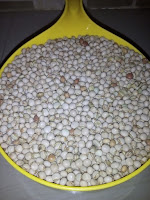I'm just thinking of where to start from, to release this recipe because of it's local nature. Well, I think I'll start from ji which is yam in English. Ji is Igbo name for yam and is well planted in Nigeria, especially the Northern part. This Ayaraya dish we have here is an Nsukka food rich in protein (the beans) and carbohydrate (the yam). It is just like okpa which doesn't need much ingredients. Another relationship is that both meals require enough oil, uziza and pepper. here. Now back to business, preparing ayaraya is not very tasking except you may have to be a little patient as it could take up to 2hours or more to be ready except you are using pressure cooker to cook the beans. The beans used for this dish is called fio-fio, a.k.a pigeon peas. To understand the ayaraya concept, I would say that ayarara (Nsukka dialect) means a mixture of something. ji (yam) attached to its name. So, in preparing ayaraya ji, you have to ensure that yam is of greater quantity than the pigeon peas. Now the recipe:
So, this dish is a mixture of two ingredients being yam and pigeon peas, with yam as the major ingredient. That is why it has To learn how to cook okpa, click
Ingredients
1. 4 cups of pigeon peas (ogamgam is the type that doesn't take much time to cook. See picture)
2. Half tuber of good, old yam (Ji ohuru or new yam is not good for this meal because it is slimy)
3. One large bulb of Onion
4. Little mixture of Ose Nsukka (Yellow pepper) and Otanjere (Nsukka red pepper) or any pepper
5. One tablespoonful of Uziza
6. Ukpaka or Ugba - Made from Oil bean, shredded. I use the well fermented one to bring out the aroma in the food. It's not advisable to use the unfermented akpaka as this may add its bitter taste in the food. The fermented one is usually very soft and oozing.
7. Two milk cups of fresh red palm oil
8. One stock cube (I used only 1 cube. I forgot to remove one before snapping)
9. Salt to taste
Procedure
1. De-stone the fio-fio (pigeon peas) and pour in a pot of boiling water
2. Cook until soft, but not soggy (see picture)
3. Cut your yam into pieces and place on top of the boiling fio-fio before it finally gets cooked, so the water cooks the yam. At this point, you can add salt by sprinkling it over the yam so it penetrates the yam down to the beans. Do not add all the salt needed for the cooking as you will need to add salt when preparing the sauce
4. When the peas and yam are done, set aside and then mash the yam in a mortar. Do not mash much so the yam wouldn't turn to pounded yam. Some people use knife to cut the yam into pieces, but using mortar and pestle is good, giving it the local effect needed.
5. To prepare the sauce, cut the onions into tiny pieces as if you are preparing stew and them grind the balls of pepper and a little more onions together.
6. Pound the uziza as well.
7. Place a dry pot on the burner and add the palm oil
8. After 1 minute, add the onions. We add the onions immediately so as not to allow the palm oil to bleach as it affects the taste and colour of the dish.
9. Add the grounded pepper and onions after 2 minutes, add the uziza
10. Now you can add the stock cube and stir.
11. Add a little salt, bearing in mind the initially added salt to the pigeon peas and yam.
12. Add the ukpaka/ugba/oil bean
13. Pour the mashed yam and pigeon peas to the oil sauce
14. Use wooden spoon to mix together until the sauce is evenly distributed and you have your ayaraya ready to eat!
I hope you try this at home. Please do and give us your feedback!








 https://orcid.org/0000-0002-0562-2648
https://orcid.org/0000-0002-0562-2648










woow,
ReplyDeleteone of the best food in Nsukka
You got it. I love it.
Delete